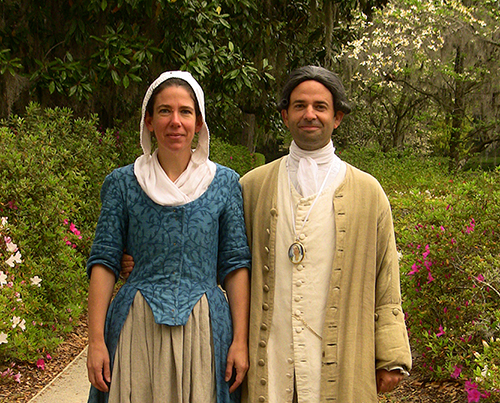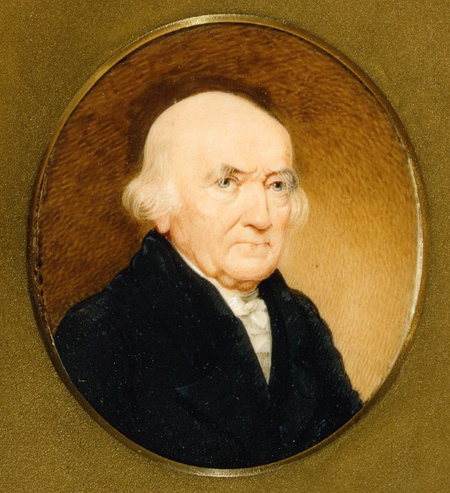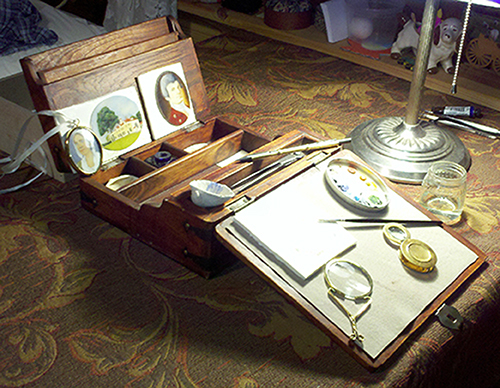There can be no doubt that our interest in miniature painting was most certainly influenced, and nurtured by studying, admiring, and conversing over the incredible collection of original miniature paintings housed at the Gibbes Museum of Art. South Carolina seems to have been particularly fond of miniature painting, as evidenced by many resident miniature painters, itinerant miniature painters, and patronage of its citizenry over the centuries.

For Renee and me, the interest we share in the fine arts, along with our interest in 18th century history has, for us, its perfect marriage in miniature painting. We decided to seek out an instructor of this discipline, and truly found a gem. Under the tutelage of Mrs. Joan Cornish Willies, a member of the Royal Miniature Society of England, we have been learning the European mode of miniature painting. Ms. Joan has been painting miniatures since around 1937 and has kindly taken us under her wing. She has brought an almost extinct art form back to life for us.

We consider it an honor and blessing to have her as an instructor, a considerable resource, and now a dear friend. Ms. Joan has taught us how to mix our own paint from gemstone pigments such as Lapis Lazuli, and Jasper. Much in the spirit of Charleston’s own Charles Fraser, we take great satisfaction in mixing our own pigments when possible to not only get a more unique and valuable miniature made of precious materials, but also to use pigments which have shown they will stand the test of time. At present, I am painting a miniature portrait of Renee that is 2 and a half inches high and utilizes Lapis Lazuli blues, Jasper reds, and Amethyst for some purples, with 24 carat gold lettering that will be housed in a 24 carat gold oval frame meant to be worn.
I initially began painting in oils, but am now using watercolors, which is the medium used in many of the miniatures at the Gibbes. Using a series of nearly a half a million cross hatches, strokes, and dots per painting, the portrait begins to take life. Only small amounts of paint are used. The watercolor is built up slowly, all the while allowing the bright color from the ground or material painted on to show through. A letter from 1800 which describes the painting process in great detail, as well as a treatise written by Nicolas Hilliard during the reign of Elizabeth I, are source materials for using period techniques and getting into the process of these works of art that are also worn as jewelry. Having its roots in Medieval Illumination, Hans Holbein the Younger brought miniature painting to England, and was court painter to King Henry VIII. From the 1530’s to the present, it is fascinating to see how the the miniature has evolved and is still a much valued art.

Renee is painting subject miniatures in oils while I am focusing mostly on portraits in watercolor. Our presentation at the Gibbes will show the watercolor technique using period appropriate materials, all from a teak wood box that can be neatly tucked under my arm and carried about from place to place, much like those of the 18th and 19th centuries. We will explain some of the tools, techniques, and pigments, and share with the audience our passion for what we consider one of the most fascinating forms of art not only from our past, but also relevant to the present.
Join David, Renee and Gibbes Curator of Collections, Sara Arnold to learn more about the art of miniatures with Tokens of Affection: Miniature Portraits from the Gibbes Collection.
Saturday, September 27, 10am-12noon
Location: The Charleston Museum, 360 Meeting Street,
$35 Gibbes and Charleston Museum Members, $40 Non-Members
To register, please visit gibbesmuseum.org/events or call 843.722.2706 x21.
Renee Gillespie, has a Bachelor Degree in Art from Washington College in Chestertown, MD, and also studied at the School of the Art Institute of Chicago. Renee is currently practicing the nearly lost art of miniature painting. Taking instruction from a member of England’s Royal Miniature Society, the oldest miniature society in the world, Renee has been learning the art and discipline in the European Mode. Renee also is gifted in Natural Dyeing, and Batiking. Her Indigo Dyed Cloth has been purchased by the Smithsonian Institution.
David Gillespie, is a full time stone carver, miniature painter, and a 10th generation South Carolinian. He also has authored the recent book, A Brief Treatise on Tomb and Grave Stones of the Eighteenth Century. David is a member of the Association for Gravestone Studies, Pickens County SC Historical Society and is a grant recipient of the South Carolina Arts Commission for his stone work. He has just been selected by the magazine Early American Life as one of America’s Best Craftsmen and selected for the Directory of Traditional Crafts in the August 2014 issue.
More about David and Renee can be found at their website at pumpkintownprimitives.com
Published September 19, 2014

